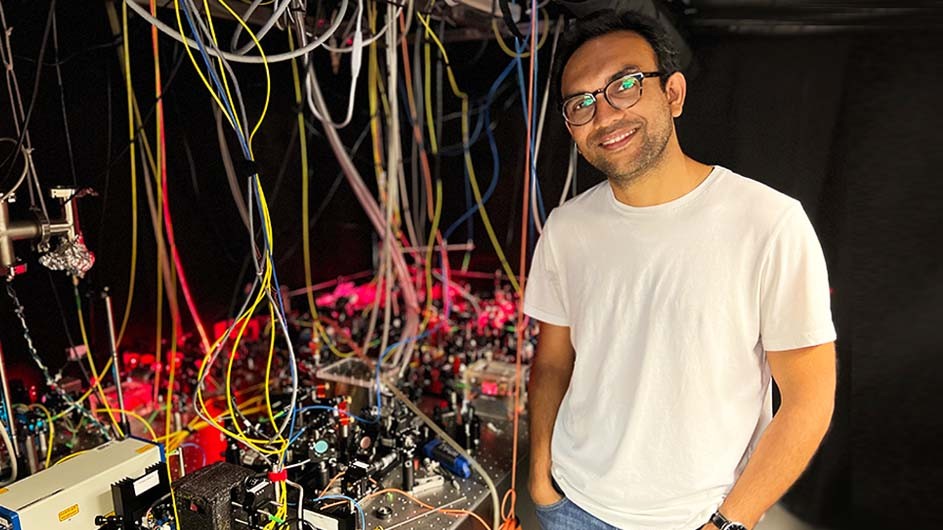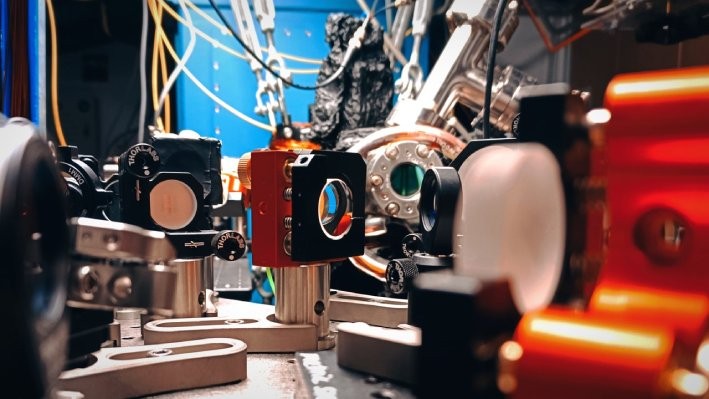From Atoms to Molecules and Back Again
Debayan Mitra, a polyglot postdoc working with physicist Tanya Zelevinsky, is building an ultracold toolbox of atoms, molecules, and atoms-split-from molecules to understand the tiny world of quantum mechanics.

The universe is, fundamentally, quantum mechanical in nature. Quantum mechanics is the study of the very small—particles that move in waves with counterintuitive properties, like an ability to be in two places at once or to be “entangled” such that one particle knows exactly what’s happening to another, even if they are very far apart—a discovery was just awarded this year’s Nobel Prize in Physics.
Human beings too are made of quantum mechanical particles, but at our macroscopic scales, quantum phenomena give way to the rules of classical mechanics. The microscopic world can be very different. To study it, you need to think very small and very, very cold.
At Columbia, experimental physicists Tanya Zelevinsky and Sebastian Will use laser beams to cool atoms and molecules down to just a few degrees above absolute zero—that’s around -460 °F. At such low temperatures, the atoms and molecules go from moving around at hundreds of miles per hour to just a few millimeters per second or slower. This lets researchers “trap” them in place to study their quantum mechanical properties, repurpose them as quantum simulators of phenomena that can’t be realized experimentally yet, or use them to ask fundamental questions about the very nature of the universe
Debayan Mitra, who joined Columbia in 2021, is one of the postdocs who works closely with Professor Zelevinsky on her quest to cool molecules and inspect them. In this Q&A, he explains what brought him to campus and why he is so intrigued by the ultracold.
Your foray into physics started with a bit of a failure. Can you explain?
I was born in Kolkata to two engineers and was expected to follow in their applied footsteps and become either an engineer or a doctor. However, I was always inclined toward science and interested in tinkering and experimentation, but pursuing a career in experimental physics wasn’t exactly encouraged because of the fewer job prospects.
In India, there is a very competitive standardized test to get into the Indian Institutes of Technology—the premiere undergraduate institutes in the country—and I did not do very well. In hindsight, that was actually a great thing. I had an excuse not to go into a technical field and could pursue more fundamental research instead. I went to a small college in Kolkata called Presidency College, where I cemented my deep interest in physics.
From there you were off to Europe, where you found another love in addition to science?
After completing my undergraduate degree, I earned a scholarship to École Polytechnique in Paris. That was a dream but came with a catch: all my classes would be in French. For my first semester, I lived with a host family in a rural area of Normandy with very few English speakers. Learning French allowed me to complete my master’s in physics and helped me realize that I have a love for languages too.
I now speak five: Bengali, my mother tongue; Hindi, the national language of India; English, which I learned in kindergarten; French; and, since moving to the U.S., Spanish.
Can you draw any parallels between learning science and learning a language?
Different parts of the brain are required, but I think learning a language and learning science are very complementary. With language, you need to learn how to switch from one to another, and you can’t be afraid of making mistakes or looking dumb—that’s how you learn. A similar openness to new ideas is also a fundamental building block of physics.

From France, how did you come to Columbia?
During my PhD at Princeton, I used ultracold atoms as a testbed to study quantum mechanics. There, I studied a quantum mechanical phenomenon called superconductivity, in which electricity is transmitted without losing any energy in the process. Scientists in both academia and industry want to find superconducting materials that can work at room temperature—those discovered so far need to be kept impractically cold—so I built a quantum simulator from trapped atoms that we could use as analogs of electrons to observe their behavior under different conditions. We got some useful information, but it turns out atoms are just a little too simple to crack the problem. So I turned my attention to molecules.
Because molecules are more complicated than single atoms, you can do more complicated studies with them. I joined John Doyle’s group at Harvard for my first post-doc, where I helped adapt the cooling techniques perfected over the past few decades for atoms to two- and even three-atom large molecules. We also successfully cooled the largest molecule to date. Now at Columbia, I’m working with Zelevinsky to expand the toolbox of molecular candidates even more.
Are any molecules especially interesting?
Plenty, but at the moment we are most excited to cool molecules as a means to produce an atom: hydrogen.
"It’s exciting to tackle a problem no one has before, but also a little nerve-wracking. You don’t know where you will end up, but that’s the beauty of fundamental research."
Hydrogen is the simplest atom that exists in nature, and theoretical physicists can precisely calculate all of its quantum mechanical properties. We need to test those predictions experimentally—doing so would either confirm that quantum mechanics works the way we think it does or reveal gaps in our understanding—but hydrogen atoms cannot be directly laser cooled. Doing so would require a laser so ultraviolet in color that just turning it on would ionize the air around it and cause fires.
We think we’ve found a way to circumvent that problem. Rather than trying to cool hydrogen alone, we thought, why not cool a molecule that contains it instead? We recently demonstrated that molecules containing calcium and hydrogen can be laser cooled; right now, we are figuring out how to break off the hydrogen.
What are some of the challenges of laser cooling?
It involves a lot of lasers that all have to be stable and perfectly in tune, but it’s a manageable task. There are always technical difficulties, but we’ve been able to solve everyone we’ve encountered so far. It’s exciting to tackle a problem no one has before, but also a little nerve-wracking. You don’t know where you will end up, but that’s the beauty of fundamental research.
What are your plans post-Columbia?
There’s a growing trend away from academia, but I really hope to become a professor. The career is full of compromises, and I’ll have to navigate the two-body problem with my partner, but I believe academia offers something other jobs don’t. It’s intellectually so stimulating, and I really appreciate the mentoring and training aspect of academia—I think that is academia’s biggest role, and the biggest breakthrough you can achieve is cultivating scientific interest in students. I haven’t found the solution yet, but I want to keep fighting to stay.
